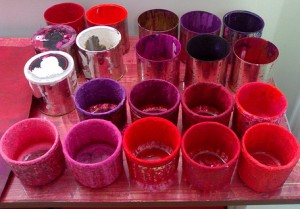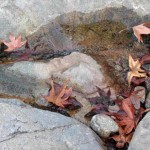Just Paint! Methodology & The Nitty Gritty
 Today in the Sunday paper, there was an article by Marni Jameson describing a new book on preparing surfaces for paint (not any actually painting mind you) in which there are 194 pages and the statement: “Read the text completely before beginning surface preparation.” After total overload set in (caused in part by 5 paragraphs on choosing the correct masking tape), Marni called the author of the book and was told that she should “just paint.” Here are a couple of ways to take the “just paint” metaphor and run with it musically.
Today in the Sunday paper, there was an article by Marni Jameson describing a new book on preparing surfaces for paint (not any actually painting mind you) in which there are 194 pages and the statement: “Read the text completely before beginning surface preparation.” After total overload set in (caused in part by 5 paragraphs on choosing the correct masking tape), Marni called the author of the book and was told that she should “just paint.” Here are a couple of ways to take the “just paint” metaphor and run with it musically.
Surface Preparation as Methodology
I have encountered articles and books and attended workshops and conference sessions in which there were pages and/or hours devoted to exhaustive musical prepping of surfaces- systems for practicing, or posture, or the exact angles of the fingers, or matters of technique. You get the picture.
I get a bit testy sometimes over this kind of stuff. I try to glean what I can from it in order to have a variety of pedagogical tools (the right ones for the right jobs), but sometimes I feel that the issue is really one of control on the part of the authors and presenters. They are giving us uni-taskers- tools that only work when such and such a condition exists. Students are human beings and come in a variety of makes and models.
In the earlier years of study, of course a student needs careful instruction. But some people have a more natural affinity for the piano than others. Some people have physical or learning limitations. If a person is able to play well, has a decent foundation, and a system that works for them, maybe they should go ahead and “just paint” like Marni. That’s not to say that we won’t help the student choose appropriate repertoire or try to fine tune things as we go—in fact, we must do these things in order for growth to take place.
I’ve posted plenty on laying a solid foundation, but I don’t believe for one minute that there is only one way to do it or that a person without that perfect background must start over completely.
Surface Preparation as Nitty Gritty
One might also think of surface preparation as learning the basics of a piece; notes, counting, rhythm, dynamics, tempo, phrasing, style, and technique—aka the nitty gritty. We have a saying in our studio INATN (it’s not about the notes). I have found many students get really stuck somewhere in the intermediate years when suddenly the lesson focus subtly shifts from fundamentals to message.
Some will constantly worry about the patched hole in the wall and not go for the message because the prep work is not yet perfect. Others will gloss over the notes, rhythm, and phrasing and just paint, ignoring blemishes willy-nilly in order to get straight to the message.
After a certain point, I’m not so sure you can separate the nitty gritty from the message. You need to message to play the notes and the notes to express the message. Mostly this certain point occurs quite a bit sooner than we think it does.
Is it possible to start from either end? Absolutely. You can be a forest person and start with the big picture working back to the details (just paint) or you can be a trees person and start with the details working out to the big picture. Either way works. As teachers we just have to adjust to our students ways—a tricky thing indeed when our comfort zone is one way and the student’s the other.
Here is a beautiful piece you might enjoy from Natalie Mullis at Key Changes Music Therapy, Bloom Where You Are Planted



Just play:)
5 paragraphs on masking tape? Amazing. Must have been funded by a grant.
My students at Hampshire think in unconventional ways, so I have to do the same. I love it!
And I think you’ve said exactly what you wanted to say, very well. 🙂
Here is an example that illustrates some of what I was trying to say in this post. Thanks Gretchen:)
I thought of your comment when I read this article http://www.guardian.co.uk/books/2011/mar/31/ronald-dworkin-morality-dignity-hedgehogs
Sorry to yap so much :-), but also, I think that kids twig onto expressiveness long before their technique catches up. I always think of “Come Sail Away,” which is such a lovely song with a pretty little pseudo-Baroque intro … written by someone whose trills were abominable and would have gotten him kicked out of the conservatory. Clearly, he didn’t feel that he had to achieve technical perfection before expressing something compelling.
And yet I recall an interview with Renee Fleming where she talks about a masterclass she did with vocal students who were terribly eager to express themselves artistically … and all she could say to them was that this was not the time for that, that youth must be spent in gathering technique, and later on it will be time for expression and art! Thank God Billy Joel and Elton John didn’t have that attitude! Could you imagine the magnitude of the cultural loss if they’d waited until NOW to start writing music?
If a kid is compelled to musicality and expressiveness, I wager he or she will ditch the classical music scene young and simply begin to write and perform their own stuff because they will not be able to stand being told that. Kids who are less inclined to care about musicality are the ones who will stick it out. It’s a filtering mechanism to shove truly creative kids out of classical music and into popular music, sadly. Yes, they don’t have the technique that the classical ones do, but they are unwilling to sit around until they are 50 before being permitted to think about “art.”
This seems to be shifting lately in classical music … You wind up with performers like Gabriela Montero and Zoe Keating who are about as much about self-expression as they are about technique.
Shutting up now …
I think that most kids frankly are judged on technique more than musicality, and are also judged on quantifiable things in school and other contexts as well. They simply get used to it, to the hoops they need to jump through being very strictly defined and quantified with distinct and easy-to-judge feedback on whether they have “succeeded.” Technique has for a lot of high-achieving kids been a guaranteed way to please the adults around them and be labeled successful.
“Message” isn’t only more nebulous and hard to define, but it’s almost a guarantee that if one teacher or adult thinks your “message” is wildly successful and brilliant, you will get clean up the nose of another one. An A+ is an A+ no matter what; one teacher won’t tell you that your A+ is really an F. But if your message is truly unique and compelling, it’s a lead-pipe cinch that someone else in authority will think it’s the worst thing they’ve ever heard. That which will draw out strong feelings will draw out a variety of strong feelings.
That sort of thing can be very shifting-sands to a kid who is used to success being defined more clearly, and not being so subject to judgment calls.
And honestly, kids know what adults want no matter what adults tell them they want; I remember that from my own childhood. They said they wanted expression, but they rewarded technique. And the last thing they wanted was real originality — you weren’t supposed to be yourself on stage, you were supposed to vanish and simply channel the dead spirit of the composer.
A sincere teacher who really does want to get the kids to communicate through music must understand the myriad forces working against it, including that most of the kids are in a jump-through-well-defined-hoops stage of life, most adults are disingenuous when they say they want expression over technique, classical music has for years been about the composer’s unique message and not the performer’s, and most truly original works will draw as much ire as praise.
Each of these things must be addressed and explicitly so when shifting from fundamentals to message, most of all for the high-achieving kids who are used to positive feedback as a result of quantifiable success. As a result, I’d definitely agree with you that it’s easier to focus on message if you aren’t the star performer.
Boy, I sure wish I had been the kid who could say, I’m technically awesome:) Maybe it’s easier to focus on musicality if you are technically proficient but not awesome? hmmm…
This is interesting to me. I think it does depend on the personality of the learner as you conclude. I’ve know people who run ahead and don’t bother to learn the fundamentals and who crash and burn — and are demoralized by it, and I’ve known people who think that preparing to do something is the same as doing it, and who get lost in the shuffling of their to-do lists to the point where they don’t actually do anything on them. I’ve also known people who crash and burn and who seem not to feel it, and people who like to spend endless time nitpicking minor things and find confidence in it. A good teacher really does have to determine which approach a student needs in order to absorb the basics well enough to achieve fluency on their instrument.
“I have found many students get really stuck somewhere in the intermediate years when suddenly the lesson focus subtly shifts from fundamentals to message.” This is also interesting. After years and years of technical training, it’s a tough thing to ask a kid to suddenly concentrate on something other than technique. I think to some kids it can feel like a bait-and-switch. They’ve been praised their whole lives on flawless execution, and now suddenly the game changes on them and they are expected to have “something to say.” And a lot of them seem to conclude that the “something” they want to say is “I’m technically awesome.” For a kid who has spent so much time on flawless technique, it can be quite a cruel swerve for them to realize that getting on stage and communicating “get a load of me!” is not an important enough or meaningful enough musical journey to take an audience on.